How to Get Your Phlebotomy License: Step-by-Step Guide to starting Your Career
Embarking on a career as a licensed phlebotomist can be a rewarding pathway in the healthcare industry. With an increasing demand for qualified professionals to perform blood draws and laboratory work, obtaining your phlebotomy license is an essential step. Whether you’re just starting out or looking to advance your healthcare career,this thorough guide will walk you through every step needed to become a licensed phlebotomist and kickstart your journey.
Introduction
Phlebotomy is a vital medical profession focused on drawing blood for testing, donations, or research. As a certified, licensed phlebotomist, you’ll play an essential role in patient care and diagnostics, making it a fulfilling and stable career choice. Getting licensed ensures you meet the legal and professional standards necessary to work in hospitals, clinics, laboratories, and blood donation centers.
Understanding the Role of a Licensed Phlebotomist
Before diving into the licensing process, it’s helpful to understand what a phlebotomist does and why licensure is important.
- Perform blood draws using various techniques
- Ensure patient comfort and safety
- Maintain proper labeling and documentation
- Follow safety and infection control protocols
- collaborate with healthcare team members
Step-by-Step Guide to Obtaining Your Phlebotomy License
Step 1: Meet Basic Educational and Age Requirements
Most states or certifying agencies require applicants to:
- Be at least 18 years old
- Possess a high school diploma or equivalent (GED)
some programs may prefer or require prior healthcare experience or coursework.
Step 2: Enroll in an Accredited Phlebotomy Training Program
the next crucial step is completing a recognized training course. These programs typically include classroom instruction and hands-on practice:
- Course topics: anatomy, blood collection techniques, safety protocols, patient interaction
- Duration: Usually 1 to 4 months
- Format: In-person or online options available
Choose a program accredited by agencies such as the National Accrediting Agency for Clinical Laboratory Sciences (NAACLS) or approved by state health departments.
Step 3: Gain practical Experience
Most training programs include a clinical internship component, where you gain real-world experience collecting blood samples under supervision. This experience is essential for building confidence and proficiency.
Step 4: Prepare for and Pass the Certification Exam
Even though not all states require certification, earning a credential increases job prospects and confirms your skills. Renowned certifying agencies include:
| Certifying Agency | Exam Name | Requirements |
|---|---|---|
| American Society for Clinical Pathology (ASCP) | YP (Phlebotomy Technician) | Completion of training & clinical experience |
| national Healthcareer Association (NHA) | Certified Phlebotomy Technician (CPT) | High school diploma + training |
| American Medical Technologists (AMT) | Registered Phlebotomy Technician (RPT) | Training + clinical hours |
Prepare thoroughly using study guides, practice exams, and review materials provided by these organizations.
Step 5: Submit Your Application for Licensure
Requirements and application procedures vary by state. Usually, you’ll need to:
- Complete the application form
- Pay applicable fees
- Provide proof of training, certification, and identity
- Undergo background checks if required
Step 6: Obtain Your Phlebotomy License and Start Working
once approved, you’ll receive your license or certification card. With your credentials in hand, you can now apply for phlebotomy positions in hospitals, clinics, labs, or blood donation centers. Remember, maintaining licensure may involve continuing education requirements, so stay updated on best practices and new regulations.
Benefits of Getting Licensed as a Phlebotomist
- Increased job opportunities and employability
- Higher earning potential
- Recognition as a qualified healthcare professional
- Enhanced credibility and trust with patients and employers
- Legal authorization to perform blood draws in licensed facilities
Practical Tips for Aspiring Phlebotomists
- Research your state’s licensing requirements early
- Select an accredited training program that offers hands-on practice
- Gain as much clinical experience as possible during training
- Prepare thoroughly for certification exams
- Network with professionals in the field for job opportunities
Case Study: A Successful Transition into Phlebotomy
Meet Jane, who transitioned from retail to healthcare. After completing a 2-month phlebotomy training course, she earned her certification through NHA, obtained her license, and secured a position at a local hospital. Her practical experience and certification helped her stand out in a competitive job market, leading to a rewarding career with steady growth potential.
Final Thoughts and Conclusion
getting your phlebotomy license is a straightforward but important process that opens doors to a fulfilling healthcare career.By understanding the necessary educational requirements, completing accredited training programs, gaining practical experience, passing certification exams, and fulfilling licensing prerequisites, you can become a licensed phlebotomist ready to make a difference in patients’ lives.
Remember, continuous learning and maintaining your certification are key to long-term success in this field. Whether you’re passionate about patient care,seeking job stability,or aiming to advance within the healthcare industry,becoming licensed in phlebotomy is your frist step toward a promising future.
